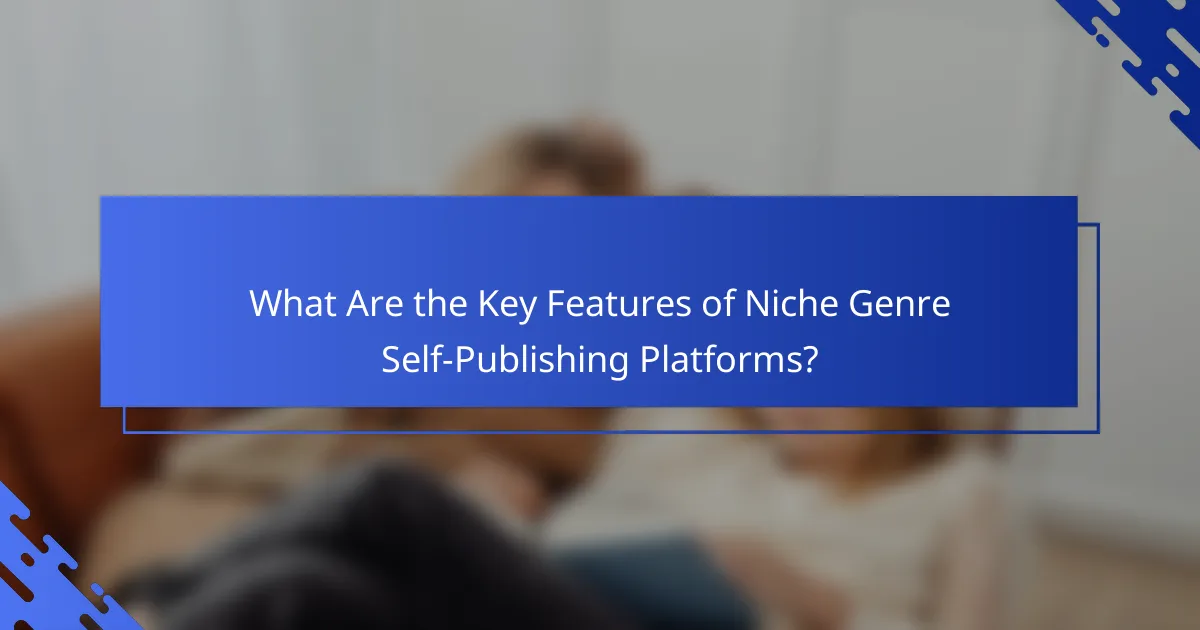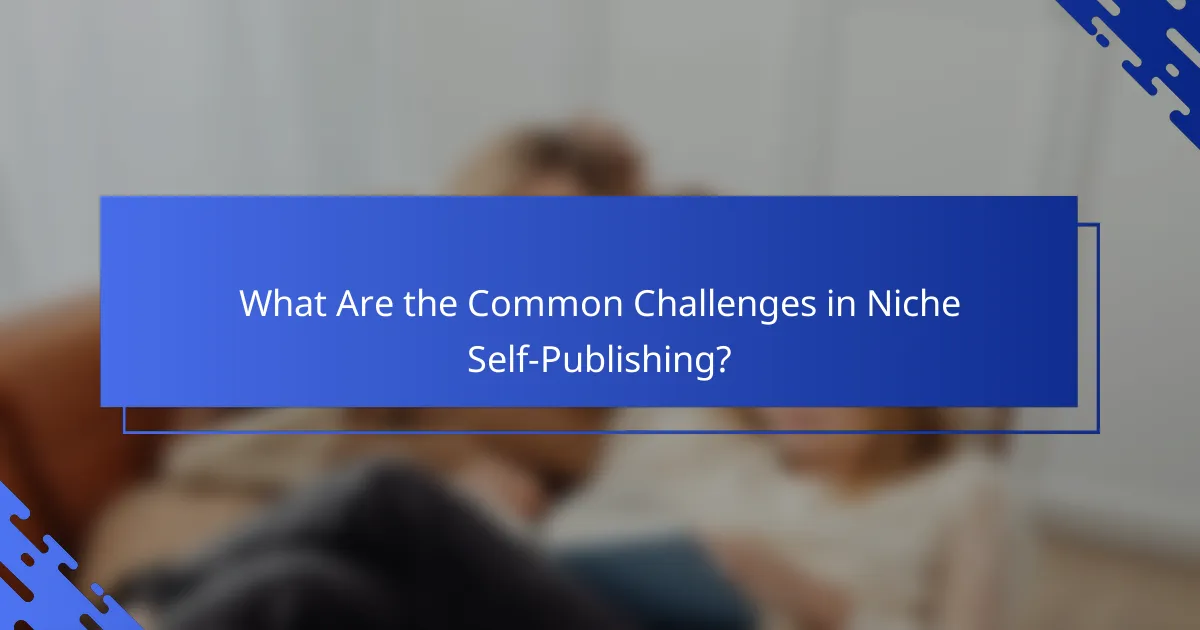Choosing the right self-publishing platform for niche genres can significantly impact your book’s visibility and sales. Each platform offers unique features tailored to specific literary markets, making it crucial to select one that aligns with your genre’s needs. By considering factors such as genre compatibility, pricing structures, and audience reach, you can enhance your chances of connecting with your target readers effectively.

Which Self-Publishing Platforms Are Best for Niche Genres?
Choosing the right self-publishing platform for niche genres can significantly impact your book’s visibility and sales. Each platform has unique features and audience reach, making it essential to select one that aligns with your genre’s specific needs.
Kobo Writing Life
Kobo Writing Life is an excellent choice for authors targeting international readers, particularly in Canada and Europe. It allows you to publish eBooks easily and offers competitive royalties, typically around 70% for books priced between $1.99 and $9.99.
This platform supports various niche genres, including romance, science fiction, and non-fiction. Kobo also provides promotional opportunities, such as featured listings, which can enhance your book’s visibility in specific categories.
Draft2Digital
Draft2Digital is a user-friendly platform that distributes your eBook to multiple retailers, including Barnes & Noble, Apple Books, and Kobo. It is particularly beneficial for niche authors as it offers wide-ranging exposure without the need to manage multiple accounts.
The platform provides free formatting tools and allows you to set your own pricing. However, keep in mind that Draft2Digital takes a small percentage of your royalties, typically around 10% of your sales.
Amazon Kindle Direct Publishing
Amazon Kindle Direct Publishing (KDP) is the most popular self-publishing platform, especially for authors in niche genres looking to tap into a vast audience. KDP offers a straightforward publishing process and the potential for high visibility through Amazon’s search and recommendation algorithms.
Authors can earn up to 70% royalties on eBooks priced between $2.99 and $9.99. However, competition is fierce, so effective marketing strategies, such as utilizing Amazon Ads or engaging in promotional pricing, are crucial for success.
Smashwords
Smashwords is a versatile platform that caters to niche authors by distributing eBooks to a wide range of retailers and libraries. It offers unique features like the Smashwords Style Guide, which helps authors format their manuscripts correctly for distribution.
The platform allows authors to set their own prices and offers a royalty rate of around 60% for sales through its distribution network. However, the user interface can be less intuitive compared to other platforms, which may require a learning curve.
IngramSpark
IngramSpark is ideal for authors looking to publish both print and eBooks, especially in niche markets. It provides access to a vast distribution network, including bookstores and libraries, which is essential for gaining physical presence.
While it charges setup fees, IngramSpark offers competitive royalties and the ability to set your own pricing. Authors should consider the initial costs and ensure they have a solid marketing plan to maximize their reach in niche genres.

What Are the Key Features of Niche Genre Self-Publishing Platforms?
Niche genre self-publishing platforms offer tailored features that cater specifically to unique literary markets. These platforms often provide specialized tools for distribution, royalty management, user interface design, and marketing that align with the specific needs of niche authors.
Distribution Options
Distribution options on niche genre self-publishing platforms can vary significantly. Many platforms allow authors to distribute their work across multiple online retailers, including Amazon, Barnes & Noble, and niche-specific sites. It’s essential to consider whether the platform offers global distribution or focuses on specific regions, as this can impact your book’s reach.
Some platforms also provide print-on-demand services, which can be beneficial for authors looking to offer physical copies without upfront printing costs. Evaluate the distribution channels available to ensure they align with your target audience’s preferences.
Royalty Rates
Royalty rates are a critical factor when choosing a self-publishing platform. Most niche platforms offer royalty rates ranging from 30% to 70%, depending on the pricing model and distribution choices. Higher royalty rates are typically associated with direct sales through the platform’s website.
It’s important to read the fine print regarding fees and deductions, as some platforms may charge for distribution or additional services, which can affect your overall earnings. Compare the net earnings across different platforms to find the best fit for your financial goals.
User Interface
The user interface of a self-publishing platform can greatly influence your publishing experience. A clean, intuitive interface makes it easier to upload manuscripts, format books, and manage your account. Look for platforms that offer user-friendly tools and clear instructions, especially if you are new to self-publishing.
Additionally, consider whether the platform provides templates or design tools for cover creation, as this can save time and enhance the visual appeal of your book. A responsive customer support team is also a valuable feature to help you navigate any technical challenges.
Marketing Tools
Effective marketing tools are essential for promoting your niche genre book. Many self-publishing platforms offer built-in marketing features, such as promotional pricing, email marketing integration, and social media sharing options. These tools can help you reach your target audience more effectively.
Some platforms may also provide analytics to track sales and reader engagement, allowing you to adjust your marketing strategies accordingly. Consider platforms that offer additional resources, such as webinars or guides on marketing for niche genres, to enhance your promotional efforts.

How Do I Choose the Right Platform for My Niche Genre?
Choosing the right self-publishing platform for your niche genre involves understanding how well the platform aligns with your specific genre’s needs, costs, and audience reach. Consider factors such as genre compatibility, pricing structures, and the platform’s ability to connect you with your target readers.
Assessing Genre Compatibility
Not all self-publishing platforms cater equally to every genre. Some platforms specialize in specific niches, such as romance, science fiction, or non-fiction, which can significantly impact your book’s visibility and sales. Research platforms that have a strong track record in your genre to ensure better alignment with your audience’s preferences.
For example, platforms like Wattpad are excellent for young adult and romance genres, while others like Kindle Direct Publishing (KDP) are more versatile but may not offer the same targeted audience engagement. Consider where similar authors in your genre are publishing and how successful they are on those platforms.
Evaluating Costs
Cost structures can vary widely between self-publishing platforms, impacting your overall profitability. Some platforms charge upfront fees, while others take a percentage of your royalties. For instance, KDP allows you to publish for free but takes a cut of your sales, typically around 30% to 65% depending on pricing.
When evaluating costs, consider not just the fees but also potential hidden costs such as marketing services or premium features. Create a budget that includes these factors to avoid surprises later on.
Understanding Audience Reach
Audience reach is crucial for the success of your self-published book. Different platforms have varying degrees of visibility and access to potential readers. For example, platforms like Smashwords distribute to multiple retailers, expanding your reach beyond just one site.
Analyze the platform’s user base and marketing tools. Some platforms offer built-in promotional tools or partnerships with bookstores, which can enhance your book’s exposure. Aim for platforms that not only host your book but actively promote it to your target audience.

What Are the Pricing Models for Self-Publishing Platforms?
Self-publishing platforms typically use three main pricing models: percentage of sales, flat fees, and subscription models. Understanding these models helps authors choose the right platform based on their sales expectations and budget.
Percentage of Sales
Many self-publishing platforms charge a percentage of each sale, which can range from around 15% to 30%. This model means that authors earn royalties based on the price of their book after the platform takes its cut.
For example, if a book sells for $10 and the platform takes a 20% commission, the author would receive $8. This model is beneficial for authors who prefer not to pay upfront costs but may be less favorable for those with high sales volumes.
Flat Fees
Some platforms operate on a flat fee basis, where authors pay a set amount to publish their book, regardless of sales. This fee can vary widely, typically ranging from $50 to several hundred dollars, depending on the services included.
This model is advantageous for authors who anticipate high sales, as they keep all revenue after the initial fee. However, it requires upfront investment, which may not be feasible for all authors.
Subscription Models
Subscription models charge authors a monthly or annual fee to access publishing services. These fees can range from $10 to $50 per month, providing authors with tools and resources to publish and promote their work.
This model can be cost-effective for authors who publish multiple books or require ongoing support. However, authors should ensure that the services offered justify the subscription cost to avoid unnecessary expenses.

What Are the Common Challenges in Niche Self-Publishing?
Niche self-publishing presents unique challenges that can affect an author’s success. Key issues include market saturation and discoverability, which can hinder visibility and sales in specialized genres.
Market Saturation
Market saturation occurs when there are too many titles in a specific niche, making it difficult for new authors to stand out. For instance, genres like romance or fantasy often have thousands of titles, leading to fierce competition.
To navigate market saturation, authors should focus on unique angles or sub-genres that are less explored. Researching trends and reader preferences can help identify gaps in the market where new content may be welcomed.
Discoverability Issues
Discoverability issues arise when potential readers struggle to find niche books among the vast array of available titles. This can be exacerbated by algorithms on self-publishing platforms that favor popular genres over niche ones.
To improve discoverability, authors should optimize their book descriptions and keywords, ensuring they align with what niche readers are searching for. Engaging with communities on social media and niche-specific forums can also enhance visibility and attract a targeted audience.
